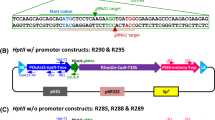Abstract
An improved method to identify the T-DNA insertion site in transgenic Arabidopsis thaliana (Columbia ecotype) genome was presented. Firstly, the pre-adaptor was amplified by PCR from the plasmid pLASC11.12.8 and digested by HindIII to produce the adaptor. After treated with calf intestine alkaline phosphatase, the adaptor was ligated to the genomic restriction digested fragment with the same restriction endonucleases. Then two rounds of PCR (nested-PCR) were carried out and an unknown sequence between the T-DNA and the adaptor was amplified. Further analysis would reveal the accurate site of T-DNA insertion into transgenic A. thaliana genome.
Similar content being viewed by others
Abbreviations
- CIAP:
-
calf intestine alkaline phospbatase
- EtBr:
-
ethidium bromide
- LB:
-
left border
- PCR:
-
polymerase chain reaction
- pre-adaptor:
-
PCR product to produce the adaptor
- RB:
-
right border
- T-DNA:
-
transferred-DNA
References
Wang, G.L. and Fang, H.Y., Plant Genetic Engineering, Bei**g: Science, 2002.
Maqbool, S.B. and Christou, P., Multiple Traits of Agronomic Importance in Transgenic Indica Rice Plants: Analysis of Transgene Integration Patterns, Expression Levels and Stability, Mol. Breed., 1999, vol. 5, pp. 471–480.
Kohli, A., Griffiths, S., Palacios, N., Twyman, R.M., Vain, P., Laurie, D.A., and Christou, P., Molecular Characterization of Transforming Plasmid Rearrangement in Transgenic Rice Reveals a Recombination Hotspot in the CaMV Promoter and Confirms the Predominance of Microhomology Mediated Recombination, Plant J., 1999, vol. 17, pp. 591–601.
Southern, E.M., Detection of Specific Sequences among DNA Fragments Separated by Gel Electrophoresis, J. Mol. Biol., 1975, vol. 98, pp. 503–517.
Triglia, T., Peterson, M.G., and Kemp, D.J., A Procedure for In Vitro Amplification of DNA Segments That Lie Outside the Boundaries of Known Sequences, Nucleic Acids Res., 1988, vol. 16, pp. 81–86.
Does, M.P., Dekker, B.M.M., de Groot, M.J.A., and Offringa, R., A Quick Method to Estimate the T-DNA Copy Number in Transgenic Plants at an Early Stage after Transformation Using Inverse PCR, Plant Mol. Biol. Rep., 1991, vol. 17, pp. 151–153.
Huang, S.H., Inverse Polymerase Chain Reaction: An Efficient Approach to Cloning cDNA Ends, Mol. Biotechnol., 1994, vol. 2, pp. 15–22.
Akiyama, K., Watanabe, H., Tsukada, S., and Sasai, H., A Novel Method for Constructing Gene-Targeting Vectors, Nucleic Acids Res., 2000, vol. 28, p. e77.
Warashawsky, D. and Miller, L., A Rapid Genomic Walking Technique Based on Ligation-Mediated PCR and Magnetic Separation Technology, BioTechniques, 1994, vol. 16, pp. 792–798.
Siebert, P.D., Chenchik, A., Kellogg, D.E., Lukyanov, K.A., and Lukyanov, S.A., An Improved PCR Method for Walking in Uncloned Genomic DNA, Nucleic Acids Res., 1995, vol. 23, pp. 1087–1088.
Zhou, Y.X., Newton, R.J., and Gould, J.H., A Simple Method for Identifying Plant/T-DNA Junction Sequences Resulting from Agrobacterium-Mediated DNA Transformation, Plant Mol. Biol. Rep., 1997, vol. 15, pp. 246–254.
Cottage, A., Yang, A.P., Maunders, H., de Lacy, R.C., and Ramsay, N.A., Identification of DNA Sequences Flanking T-DNA Insertions by PCR-Walking, Plant Mol. Biol. Rep., 2001, vol. 19, pp. 321–327.
Yan, Y.X., An, C.C., Li, L., Gu, J.Y., Tan, G.H., and Chen, Z.L., T-Linker-Specific Ligation PCR (T-Linker PCR): An Advanced PCR Technique for Chromosome Walking or for Isolation of Tagged DNA Ends, Nucleic Acids Res., 2003, vol. 31, p. e68.
Shyamala, V. and Ames, G.F., Genome Walking by Single-Specific-Primer Polymerase Chain Reaction: SSP-PCR, Gene, 1989, vol. 84, pp. 1–8.
Swensen, J., PCR with Random Primers to Obtain Sequence from Yeast Artificial Chromosome Insert Ends or Plasmids, BioTechniques, 1996, vol. 20, pp. 486–491.
Trueba, G.A. and Johnson, R.C., Random Primed Gene Walking PCR: A Simple Procedure to Retrieve Nucleotide Fragments Adjacent to Known DNA Sequences, BioTechniques, 1996, vol. 21, p. 20.
Rishi, A.S., Nelson, N.D., and Goyal, A., Genome Walking of Large Fragments: An Improved Method, J. Biotechnol., 2004, vol. 111, pp. 9–15.
Ausubel, F.M., Brent, R., Kingston, R.E., Moore, D.D., Seidman, J.G., Smith, J.A., and Struhl, K., Short Protocols in Molecular Biology, New York: John Wiley and Sons, 1995.
Author information
Authors and Affiliations
Corresponding author
Additional information
This text was submitted by the authors in English.
Rights and permissions
About this article
Cite this article
Huang, S.C., Liu, H.Z., He, G.H. et al. An improved method to identify the T-DNA insertion site in transgenic Arabidopsis thaliana genome. Russ J Plant Physiol 54, 822–826 (2007). https://doi.org/10.1134/S1021443707060155
Received:
Issue Date:
DOI: https://doi.org/10.1134/S1021443707060155




